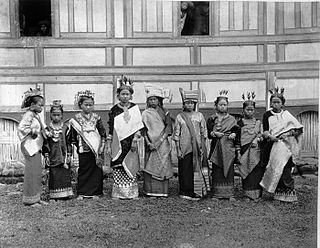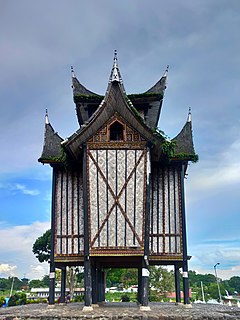Matrilineality is the tracing of kinship through the female line. It may also correlate with a social system in which each person is identified with their matriline – their mother's lineage – and which can involve the inheritance of property and/or titles. A matriline is a line of descent from a female ancestor to a descendant in which the individuals in all intervening generations are mothers – in other words, a "mother line". In a matrilineal descent system, an individual is considered to belong to the same descent group as their mother. This ancient matrilineal descent pattern is in contrast to the currently more popular pattern of patrilineal descent from which a family name is usually derived. The matriline of historical nobility was also called their enatic or uterine ancestry, corresponding to the patrilineal or "agnatic" ancestry.

Minangkabau people, also known as Minang, are an ethnic group native to the Minangkabau Highlands of West Sumatra, Indonesia. The Minangkabau's West Sumatran homelands was the seat of the Pagaruyung Kingdom, believed by early historians to have been the cradle of the Malay race, and the location of the Padri War.

Negeri Sembilan is a state in Malaysia which lies on the western coast of Peninsular Malaysia. It borders Selangor on the north, Pahang in the east, and Melaka and Johor to the south.

West Sumatra is a province of Indonesia. On the west coast of the island of Sumatra, the province has an area of 42,012.89 km2, and it had a population of 4,846,909 at the 2010 Census and 5,534,472 at the 2020 Census. The province includes the Mentawai Islands off the coast and borders the provinces of North Sumatra to the north, Riau and Jambi to the east, and Bengkulu to the southeast. West Sumatra is sub-divided into twelve regencies and seven cities. It has relatively more cities than other provinces outside of Java, although several of them are relatively low in population compared with cities elsewhere in Indonesia. Padang is the province's capital and largest city.

An Undang is a ruling chief or territorial chief who still play an important role in the state of Negeri Sembilan, Malaysia. The name is believed to be derived from the Malay word undang-undang meaning "law".

Adat is the generic term derived from Arabic language for describing a variety of local customary practices and tradition as observed by Muslim communities in North Caucasus, Central Asia and Southeast Asia. Despite its Arabic origin, the term adat resonates deeply throughout the Maritime Southeast Asia, where due to colonial influence, its usage has been systematically institutionalised into various non-Muslim communities. Within the region, the term refers, in a broader sense, to the customary norms, rules, interdictions, and injunctions that guide individual's conduct as a member of the community and the sanctions and forms of address by which these norms and rules, are upheld. Adat also include the set of local and traditional laws and dispute resolution systems by which society was regulated.
Indonesian names and naming customs reflect the multicultural and polyglot nature of the over 17,000 islands in the Indonesian archipelago. The world's fourth most populous nation, Indonesia is home to approximately 365 ethnic groups, each with their own culture, customs, and language. The state officially recognises more than 300 of these ethnic groups. The Javanese are the largest single group, comprising around 40 percent of Indonesia's population.

Nilai is a city located between in Seremban District, Negeri Sembilan, Malaysia, close to the border with Selangor.

The saluang is a traditional musical instrument of the Minangkabau people of West Sumatra, Indonesia. It is similar to the ney in general, in that it is an oblique flute, but made of bamboo. It is related to the suling of other parts of Indonesia.

Rumah Gadang or Rumah Bagonjong "house for the Minangkabau people" are the traditional homes of the Minangkabau in West Sumatra, Indonesia. The architecture, construction, internal and external decoration, and the functions of the house reflect the culture and values of the Minangkabau. A Rumah Gadang serves as a residence, a hall for family meetings, and for ceremonial activities. In the matrilineal Minangkabau society, the Rumah Gadang is owned by the women of the family who live there; ownership is passed from mother to daughter.

Yamtuan, also known officially as Yang di-Pertuan Besar and unofficially as Grand Ruler, is the royal title of the ruler of the Malaysian State of Negeri Sembilan. The Grand Ruler of Negeri Sembilan is elected by a council of ruling chiefs in the state, or the Undangs. This royal practice has been followed since 1773. The Yamtuan Besar is elected from among the four leading princes of Negeri Sembilan ; the Undangs themselves cannot stand for election and their choice of a ruler is limited to a male Muslim who is Malay and also a "lawfully begotten descendant of Raja Radin ibni Raja Lenggang", the 4th Yamtuan.

The Overseas Minangkabau is a demographic group of Minangkabau people of Minangkabau Highlands origin in West Sumatra, Indonesia who have settled in other parts of the world. Over half of the Minangkabau people can be considered overseas Minangkabaus. They make up the majority of the population of Negeri Sembilan and Pekanbaru. They also form a significant minority in the populations of Jakarta, Bandung, Medan, Batam, Surabaya and Palembang in Indonesia as well as Kuala Lumpur, Malacca, Penang, Singapore and Brunei Darussalam in the rest of the Malay world. Minangkabaus have also emigrated as skilled professionals and merchants to the Netherlands, United States, Saudi Arabia and Australia. The matrilineal culture and economic conditions in West Sumatra have made the Minangkabau people one of the most mobile ethnic group in Maritime Southeast Asia.
Negeri Sembilan Malay is an Austronesian language spoken mainly in the Malaysian state of Negeri Sembilan and in northern Malacca in Alor Gajah. The language is spoken by the descendants of Minangkabau settlers from Sumatra, who have migrated to Negeri Sembilan since as early as the 14th century. It is often considered a variant or dialect of the Minangkabau language; lexical and phonological studies, however, indicate that it is more closely related to Standard Malay than it is to Minangkabau.

Adat Perpatih are customary laws which originated from the Minangkabau Highlands in Sumatra, Indonesia. It was founded by a Minangkabau leader named Sutan Balun or more famously known as Dato Perpatih Nan Sebatang. In Malaysia, Adat Perpatih is a combination of practices and rules of life for the Minangkabau people and other aborigins such as Semang, Temuan people, the Bersisi and the Jakun people that were mainly farmers at that time. Over time, this custom is practiced by many other ethnics including part of Malacca in particular of Masjid Tanah and part of Johor.
Simpang Durian is a small town in Jelebu, Negeri Sembilan, Malaysia. It is situated about 10 km from the Pahang border and about 130 km from Kuala Lumpur. Simpang Durian is also a popular stopover destination for super bikers from Singapore and southern states of West Malaysia to rest and refuel before proceeding to Genting Highlands.
The Indonesian Malaysians, also known as Anak Dagang are Malaysian citizens of Indonesian ancestry. Today, there are many Malaysian Malays who have lineage from the Indonesian archipelago and have played an important role in the history and contributed to the development of Malaysia, they have been assimilated with other Malay communities and are grouped as part of the foreign Malays or anak dagang in terms of race. The Malaysian census does not categorize ethnic groups from the Indonesian archipelago as a separate ethnic group, but rather as Malays. In Malaysia, the definition of Malay is a person who can speak Malay, is Muslim, and follows Malay traditions and customs, even non-natives who marry Malays and embrace Islam are also accepted as Malays. In Malaysia there is a political trend of trying to put all ethnic groups who speak Malay and happen to be Muslim under one banner - Malay. This is not the case in Indonesia where all ethnic groups have their own cultural identities that are recognized and respected by the government.

Rangkiang is a granary or rice barn of the Minangkabau people used to keep rice. The rangkiang is a distinctive feature of Minangkabau architecture. The structure is traditionally found in the courtyard of a rumah gadang, the traditional house of Minangkabau people.

The Rembau District is a district that is located in the state of Negeri Sembilan, Malaysia. The district is a stronghold of the matrilineal system known as adat perpatih, a customary practice inherited from the Minangkabaus, of Sumatra.

Minangkabau culture is the culture of the Minangkabau ethnic group in Indonesia, part of the Indonesian culture. This culture is one of the two major cultures in the Indonesian archipelago which is very prominent and influential.












